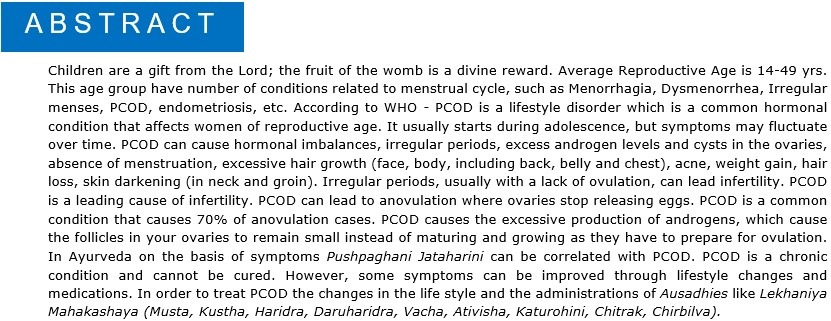Unlocking Fertility - with administration of Lekhaniya Mahakashaya in Pushpaghani Jataharini w.s.r. to PCOD
DOI:
https://doi.org/10.21760/jaims.9.2.41Keywords:
PCOD, Infertility, Bandhyatva, Lekhaniya Mahakashaya, Pushpaghani JatahariniAbstract
Children are a gift from the Lord; the fruit of the womb is a divine reward. Average Reproductive Age is 14-49 yrs. This age group have number of conditions related to menstrual cycle, such as Menorrhagia, Dysmenorrhea, Irregular menses, PCOD, endometriosis, etc. According to WHO - PCOD is a lifestyle disorder which is a common hormonal condition that affects women of reproductive age. It usually starts during adolescence, but symptoms may fluctuate over time. PCOD can cause hormonal imbalances, irregular periods, excess androgen levels and cysts in the ovaries, absence of menstruation, excessive hair growth (face, body, including back, belly and chest), acne, weight gain, hair loss, skin darkening (in neck and groin). Irregular periods, usually with a lack of ovulation, can lead infertility. PCOD is a leading cause of infertility. PCOD can lead to anovulation where ovaries stop releasing eggs. PCOD is a common condition that causes 70% of anovulation cases. PCOD causes the excessive production of androgens, which cause the follicles in your ovaries to remain small instead of maturing and growing as they have to prepare for ovulation. In Ayurveda on the basis of symptoms Pushpaghani Jataharini can be correlated with PCOD. PCOD is a chronic condition and cannot be cured. However, some symptoms can be improved through lifestyle changes and medications. In order to treat PCOD the changes in the life style and the administrations of Ausadhies like Lekhaniya Mahakashaya (Musta, Kustha, Haridra, Daruharidra, Vacha, Ativisha, Katurohini, Chitrak, Chirbilva).
Downloads
References
Susruta Samhita Of Sushruta, Vol. 1 & 2, Translated by Prof. K.R. Srikanth Murthy, Edition Second-2004, Published by Chaukhamba Orientalia Publication, Varanasi, U.P. India, Nidansthan Chapter 16 page no. 563 & Chikitsasthan chapter 22 page no.204.
Text Book of Diseases of Ear-nose- Throat: Dhingra, 2nd Edition, B.I. Churchill Living Stone Publication at New Delhi, Chapter No.42, Page No.215.
Vagbhatta's Ashtanga Hridayam, Vol. 3 (Uttar Sthan), Translated By Prof. K.R. Srikanth Murthy, Edition Reprint-2006, And Published By Chaukhamba Krishnadas Academy, Varanasi, U.P. India, Chapter 22, 184-197.
Charak Samhita By Agnivesh, Chakrapani Tika, Chaukhamba Orientela 1984, Edited By Yadavji Trikamji Acharya, Chaukhamba Prakashana, Varanasi, Edition: Reprint 2009. Chikitsa Shana 26, Page No. 889
Madhav Nidan By Madhavkara, With commentary of madhukosh by vijayrakshit & Shrikanthadatta With extracts From atankdarpan By vachaspati Vaidya, Edited By Vaidya yadhavji Trikamji Acharya-1955















